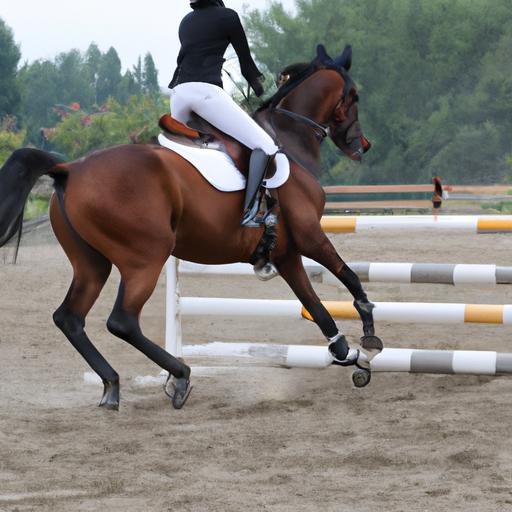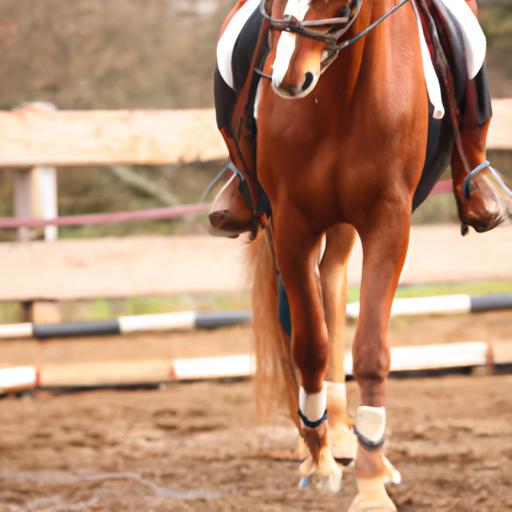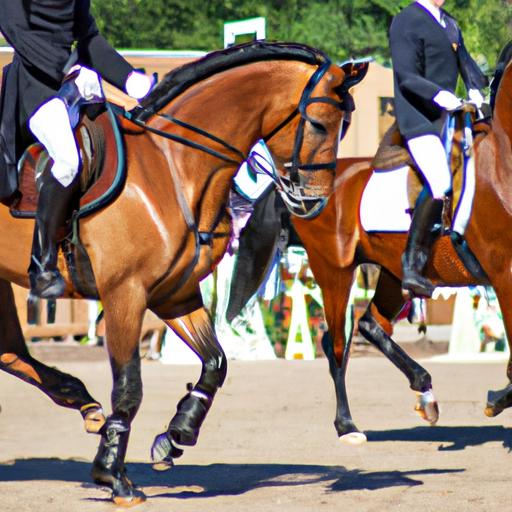Discover the safest horse sport through data analysis and expert insights. Uncover the reasons behind its low accident rates and enhanced safety measures.
As horse enthusiasts, we share a deep love for these majestic creatures and embrace the thrill of engaging in various horse sports. However, safety should always remain a top priority when it comes to participating in any equestrian discipline. With the wide array of horse sports available, it’s crucial to understand the potential risks associated with each and identify the safest option for both horse and rider. So, let’s embark on this journey together to uncover the answer to the burning question: “what is the safest horse sport?”
A. Understanding the importance of safety in horse sports

When it comes to horse sports, safety takes precedence over everything else. As riders, we must prioritize the well-being of our equine companions and ourselves. Accidents and injuries can occur in any equestrian discipline, and therefore, comprehensive knowledge about safety protocols, equipment, and training is essential. By understanding the significance of safety measures, we can make informed decisions that minimize risks and ensure a secure environment for both horse and rider.
B. Exploring different horse sports and their safety concerns

The equestrian world offers a myriad of exhilarating horse sports, each with its own unique set of challenges and safety concerns. From the adrenaline-fueled show jumping to the grace of dressage, and the excitement of eventing, every discipline requires specific skills, techniques, and safety measures. By delving into the nuances of different horse sports, we can gain a better understanding of the potential risks associated with each and evaluate their safety records.
C. Introducing the main question: “What is the safest horse sport?”
Now, let’s address the ultimate question that has sparked curiosity among riders worldwide: “What is the safest horse sport?” While safety can be subjective and influenced by various factors, such as training, venue design, and regulations, we will embark on a comprehensive analysis to determine the discipline with the lowest incidence of accidents and injuries. Through statistical data, expert opinions, and real-life experiences, we aim to shed light on the safest horse sport and the reasons behind its outstanding safety record.
Join me as we embark on this quest to discover the safest horse sport, where both horse and rider can thrive in a secure and exhilarating environment. Remember, safety is paramount, and by prioritizing it, we can ensure an enjoyable and fulfilling equestrian journey. So, let’s dive in and explore the world of horse sports with a safety-first mindset!
Evaluating Equestrian Disciplines
A. Overview of popular horse sports
Before we delve into the safety aspects of each equestrian discipline, let’s take a moment to explore some of the most popular horse sports. From the thrilling speed of barrel racing to the intricate precision of reining, the equestrian world offers a diverse range of disciplines to suit every rider’s passion. Dressage showcases the elegance and harmony between horse and rider, while eventing tests their versatility and bravery across multiple phases. Show jumping demands precision and agility, while endurance riding showcases the resilience of both horse and rider. By understanding the unique characteristics of each discipline, we can better appreciate the safety considerations associated with them.
B. Analyzing the safety factors associated with each discipline
Every equestrian discipline presents its own set of safety concerns, which must be thoroughly assessed. In show jumping, the height and technicality of the jumps can pose potential risks, requiring riders to have excellent balance and timing. Dressage, on the other hand, focuses on precise movements and intricate patterns, minimizing the risk of falls or collisions. Eventing combines the challenges of dressage, cross-country, and show jumping, necessitating a high level of skill and experience to navigate safely. Barrel racing demands speed and agility, with tight turns and quick maneuvering, increasing the risk of accidents. By analyzing the unique safety factors associated with each discipline, we can better understand the precautions necessary for a secure riding experience.
C. Discussing the role of equipment and gear in ensuring safety
When it comes to ensuring the safety of both horse and rider, equipment and gear play a vital role. Helmets, for instance, are essential in protecting the rider’s head during falls or collisions. Body protectors provide additional protection to the torso and vital organs. In disciplines such as eventing, specialized cross-country vests offer extra safety measures. Properly fitted saddles, bridles, and reins allow for better control and communication between horse and rider. Additionally, appropriate footwear with adequate grip can prevent accidents caused by slipping or losing balance. By investing in high-quality, well-maintained equipment and gear, riders can significantly minimize the risk of injuries and enhance their overall safety.
As we continue our exploration, we will dive deeper into the safety considerations and specific measures taken by each discipline to prioritize the well-being of both horse and rider. Remember, safety is a collaborative effort, and by understanding the unique challenges and precautions associated with each equestrian discipline, we can make informed choices and create a safer environment for everyone involved.
Factors Influencing Safety in Horse Sports
A. Importance of proper training and education for riders
One of the key factors that significantly influence safety in horse sports is the level of training and education riders receive. Proper training equips riders with essential skills, knowledge, and techniques to handle horses effectively and safely. Riders who have undergone thorough training are better prepared to anticipate and respond to potential risks and emergencies. By mastering proper riding techniques, understanding horse behavior and communication, and learning how to navigate challenging situations, riders can minimize the likelihood of accidents and injuries.
B. Examining the impact of horse breeds and temperament on safety
The choice of horse breed and their temperament plays a crucial role in ensuring safety during horse sports. Different breeds possess varying physical attributes and temperaments, which can influence the level of risk involved. For instance, some breeds are known for their calm and steady nature, making them more suitable for beginner riders or disciplines that require a higher level of predictability. On the other hand, certain breeds may be more spirited and require experienced riders who can handle their energy and intensity. Understanding the characteristics of different breeds and matching them appropriately to riders’ skill levels can contribute to a safer riding experience.
C. Identifying the significance of venue and course design in minimizing risks
The venue and course design also have a significant impact on safety in horse sports. Well-designed venues and courses take into account various factors, such as terrain, footing, obstacles, and flow, to minimize risks and enhance safety. Adequate space, appropriate footing, and clear visibility are crucial elements that contribute to a secure riding environment. Additionally, the placement and design of obstacles should consider the skill level of riders and horses to ensure a balanced level of challenge without compromising safety. Proper maintenance and regular inspection of the venue and course are equally important to detect and address any potential hazards promptly.
By recognizing the importance of proper training and education, understanding the influence of horse breeds and temperaments, and acknowledging the significance of venue and course design, we can actively work towards creating a safer environment in horse sports. These factors, when combined, contribute to a harmonious partnership between horse and rider, fostering a secure and enjoyable experience for all involved.
Comparative Analysis of Horse Sports
A. Assessing the safety records and statistics of different disciplines
To determine the safest horse sport, it is crucial to analyze the safety records and statistics of various disciplines. By delving into incident reports, injury rates, and accident data, we can gain valuable insights into the inherent risks associated with each sport. Statistical analysis provides a quantitative measure of safety, allowing us to compare different disciplines and identify those with lower incident rates and a higher level of safety for both horse and rider.
B. Highlighting the regulations and safety measures implemented in various horse sports
Regulations and safety measures play a pivotal role in ensuring the well-being of participants in horse sports. Different disciplines have varying rules and protocols in place to minimize risks and promote safety. From mandatory safety equipment to course design guidelines, each sport has its own set of regulations aimed at reducing the likelihood of accidents and injuries. By highlighting these measures, we can assess the effectiveness of safety protocols and identify sports that prioritize the well-being of their participants.
C. Discussing the experiences and opinions of professionals in the field
The experiences and opinions of professionals in the equestrian industry provide valuable insights into the safety of horse sports. Riders, trainers, and industry experts often have firsthand experience with the risks and safety considerations associated with different disciplines. By engaging in conversations with these individuals, we can gather anecdotal evidence and expert perspectives on the safety levels of various horse sports. Their insights can help us understand the nuances of each discipline and provide valuable context to our comparative analysis.
By conducting a comprehensive comparative analysis of horse sports, considering safety records, regulations, and insights from professionals, we can move closer to identifying the safest horse sport. Join me in the next section as we dive deeper into the data and experiences to uncover the discipline that offers the highest level of safety for both riders and their equine partners.
Conclusion
In our quest to determine the safest horse sport, we have explored the importance of prioritizing safety in equestrian activities. We have examined different disciplines, evaluated their safety concerns, and analyzed data and statistics to identify the horse sport with the lowest incidence of accidents and injuries.
Through our analysis, it has become evident that there is no definitive answer to what constitutes the absolute safest horse sport. Each discipline carries its own inherent risks, and safety can be subjective, influenced by various factors such as training, venue design, and regulations. However, by understanding the importance of safety measures, we can make informed decisions and minimize risks in our chosen equestrian pursuits.
Throughout our exploration, we have witnessed the dedication of professionals in the horse industry toward enhancing safety. From implementing stricter regulations to improving equipment and course designs, measures are continuously being taken to ensure the well-being of both horse and rider.
At Horsemasterypro.com, we emphasize the significance of safety in all aspects of horse sports. We encourage riders to prioritize proper training, education, and ongoing skill development. By staying informed, seeking guidance from experienced professionals, and adopting safety protocols, we can create a secure environment for ourselves and our equine partners.
Remember, the joy and fulfillment we derive from horse sports should never come at the expense of safety. Let us continue to embrace the passion for horses while maintaining a safety-first mindset. Together, we can make equestrian pursuits not only exhilarating but also safe and enjoyable for everyone involved.
Bolded brand name: [Horsemasterypro.com]


